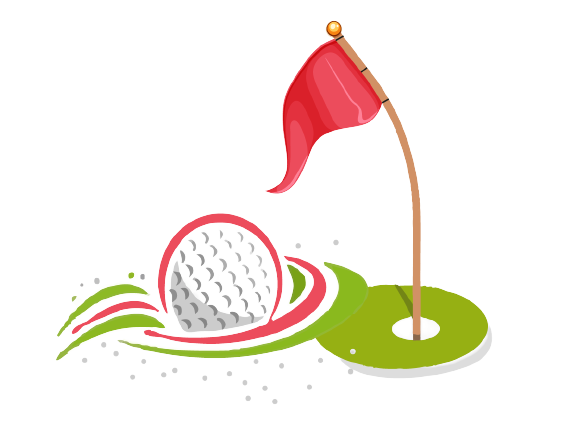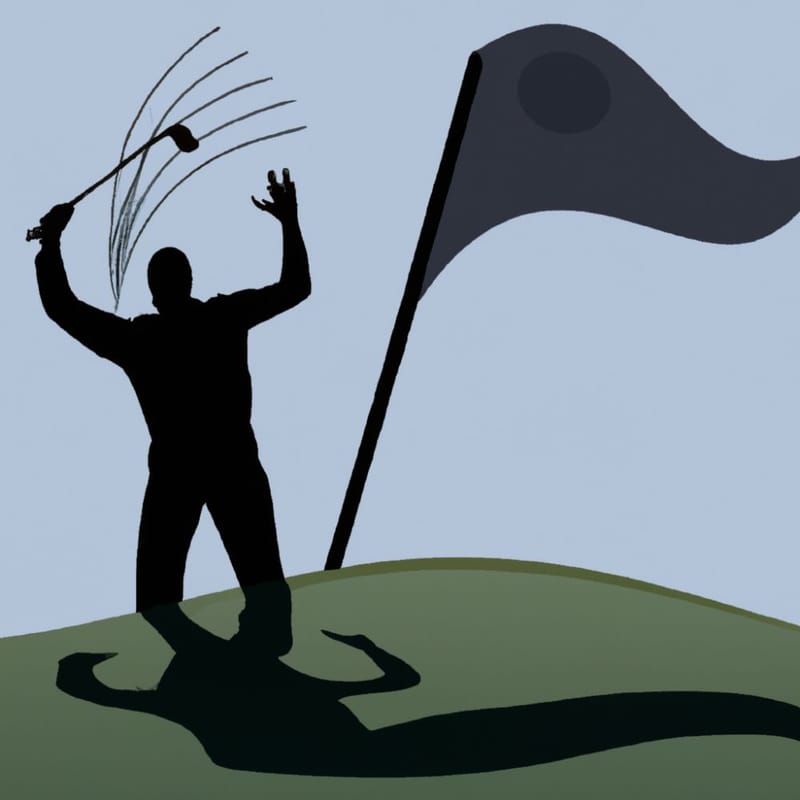Content Summary
Chipping Basics
Chipping is a vital part of the game of golf, and can be the difference between a good score and a great score.
Chipping can be done with a variety of different clubs, but the most important thing is to get the ball up in the air and close to the hole. In this section, we'll cover the normal basics of chipping and how to get started.
In the beginning, the fundamental rule in chipping was - get the ball rolling as quickly as possible. Older pro golfers chipped with any club from a sand wedge up to even a 3-iron.
The players selected the club according to distance from the approach area to the greens edges. The greens contours or any obstruction plays a major part in choice of club as well.
In the past fifteen years or so pros and amateur players alike have used a single club such as a sand or pitching wedge for every round and every chip.
When you chip well you make more putts, period.
Set up
To set up for a chip shot, place the ball in the middle of your stance and lean your weight slightly forward. Your feet, hips, and shoulders should all be in line with the target. Grip the club lightly and keep your wrists firm.
Take a short backswing, keeping your arms close to your body, and accelerate the club through impact. Follow through with your body and arms until you’re balanced on your front foot.
Grip
There are four different ways you can grip the golf club: overlapping, interlocking, 10-finger and baseball. The most common is the overlapping grip, where the pinky finger on your trailing hand is interlocked with the index finger on your leading hand.
Many professionals overlap their grips, but you might want to try different ones to see what feels most comfortable. You can also experiment with different sizes of grips.
Most golfers grip the club too tightly, so if you find yourself doing that, try loosening your grip slightly. Remember to grip the club lightly in your leading hand — you should be able to hold it up with just that hand without any problem.
Stance
Your feet should be shoulder-width apart, with your weight evenly distributed. Your grip should be firm but relaxed. Chipping is not a power shot, so you don't need to grip the club tightly. You also don't need to take a huge backswing; the club should move only a few inches to a few feet.
The Chip Shot
A chip shot in golf is a shot that is meant to travel a short distance and land softy on the green. Many golfers forget about this shot or think it is too difficult, but it can be a very useful tool in your bag.
When executed properly, a chip shot can get you out of tough situations and help you make those difficult par putts.
Contact
The most important thing to remember when chipping is to keep the clubface square to your target line throughout the swing. This will ensure solid contact and accurate shots. Here are a few extra pointers to help you with your chipping technique:
-Use the hinge and hold method. Then swing the club back and forth along your shoulder line, maintaining a relaxed grip.
-Hit the ball squarely with the clubface, using a smooth, pendulum-like motion.
-Follow through after impact, letting the club swing up along your shoulder line.
Follow Through
As with most golf shots, you’ll want to maintain your follow through until the ball has come to rest.
When chipping, this is especially important because it will help to ensure that you hit the ball with the club’s sweet spot, which is located in the center of the clubface. A good follow through will also help you to control the shot’s trajectory and spin.
Common Mistakes
Over swinging/Under swinging
New golfers often make the same mistakes when chipping the ball. These mistakes can be easily avoided with a little bit of practice.
The most common mistakes are using too much power. This can cause the ball to roll too far past the hole or another common mistake is not using enough power. This can result in the ball bouncing off the club face and not going where you want it to.
Fat shots
A fat shot occurs when the clubhead strikes the ground before it hits the ball—or “fat”—and can often lead to a loss of distance and accuracy.
There are a few different things that can cause a fat shot, but one of the most common is having the ball positioned too far back in your stance.
This robs you of power and control, and makes it more likely that you’ll catch the ground with your club before hitting the ball.
Another common cause of fat shots is dipping your left shoulder on your downswing. This causes you to lose your balance and makes it more difficult to make solid contact with the ball. It also increases the likelihood of hitting the ground before the ball.
If you want to avoid fat shots, be sure to position the ball slightly forward in your stance, put weight on your left foot and keep your shoulders level throughout your swing.
Taking a few extra practice swings might also help you get a feel for where the club should make contact with the ground.
Thin shots
One of the common mistakes that golfers make is taking too thin of a divot when they chip the ball. When you take a thin divot, it often causes the ball to go flying way too high in the air and come up way short of the hole.
The next time you are chipping, make sure to take a nice big divot with your golf shot. You want to hit down on the ball and take a sweeping motion through the ball.
This will help keep the ball down and also help you control your distances much better.
Practice
Drills
1) Place a golf ball 10 inches away from your toes. With a sand or pitching wedge make swings trying to hit the ball in the same spot each time. The club should come down in the same place on the golf ball for each shot.
2) Set up five golf balls in a line perpendicular to your toes, with each golf ball 4 inches apart. Using a pitching wedge, hit each ball in succession.
After hitting the fifth ball, set the line up again and repeat until you have made 50 total swings.
Tips
There are a few things you can do to improve your chipping technique and make the game more enjoyable. Here are some tips:
- Use a light grip and keep your hands close together on the club. This will help you control the club and keep your shots from going wild.
- Don’t swing too hard. A light touch is all you need to get the ball where you want it to go.
- Keep your head down and watch the ball as you hit it. This will help you stay focused and make sure you hit the ball in the sweet spot. Take your time out on the golf course.
- Practice, practice, practice! The more you do it, the better you’ll become at chipping. You can also try different clubs to find one that works best for you.
FAQ's
What's the best way to chip in golf?
There's no one definitive answer to the question, "how to hit a chip shot in golf?" As the best way to chip in golf will vary depending on the situation and the individual golfer's strengths and weaknesses.
However, some tips on chipping in golf that may be helpful include: making sure the clubface is square to the target, keeping your weight forward, and using a smooth, controlled swing.
How do you chip a golf beginner?
How to chip in golf for beginners? That's always the question for folks starting out in golf. There are a few things you can do to improve your chipping as a golf beginner. First, make sure you are using the correct golf clubs. A pitching wedge or 9-iron is usually best for most beginners.
Second, take a few practice swings to get a feel for the golf swing before you hit the ball. And finally, when you make contact with the ball, try to keep your left wrist firm when you hit it in the center of the clubface for maximum control and accuracy.
What is the rule of 12 in Chipping?
The rule of 12 in chipping means that you should aim to land the ball 12 inches past the hole. This will give you a good chance of making the putt.
Is it better to chip or pitch?
Pitching is generally considered the better option, as it allows for more control and accuracy. Chipping can be more difficult to master and can often result in a less precise shot.
Why is chipping so hard?
Chipping is difficult because it requires a lot of precision. You have to hit the ball at just the right angle and with just the right amount of force in order to make it go where you want it to.
It's also important to have a good grip on the club and to keep your arms straight. And not hit the ball with the leading edge of the club.
Bonus Question - What is the key to chipping?
There is no one key to chipping, as there are many different ways to chip a golf ball. However, some important things to keep in mind when chipping are: grip, stance, and club selection.
For grip, you want to make sure you have a light grip on the club and that your hands are in front of the ball.
For stance, you want to be sure you are balanced and have your weight shifted slightly forward onto your left side.
Have a set of chipping clubs you focus on and practice chip shots with these until you master them.
Conclusion
Chipping in golf is a skill that can be learned by anyone with practice. It is important to remember the basic principles of chipping, such as using a wedge and keeping your grip relaxed. With a little bit of patience and practice, you'll be chipping like a pro in no time!
Thank you for visiting and we hope to see you back soon!






